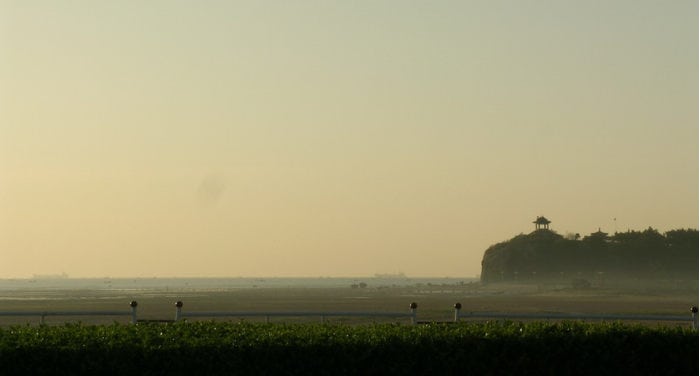
This article is a practical guide for traveling in the province of Hebei. Here are the subjects we’ll consider in this guide:
- Some basic information on Hebei Province;
- How to get there, where to stay and how to get around the province;
- The main tourist destinations.
Hebei, the land north of the river
The name of the province means just that: Hebei (河北), to the north of the river, more specifically the Yellow River, in contrast with bordering Henan Province (河南), which mostly occupies the territory south of this body of water.
With its over seventy million inhabitants, Hebei can generally be identified as the area that surrounds the two enormous cities of Beijing and Tianjin. The weather is temperate but very cold in winter, hot and rainy in the summer, and extremely windy in the Spring.
We suggest the beginning of Autumn as the best time to visit the region when the temperature is mild and the days are fresh and clear.
Why and how to visit Hebei
As was already mentioned, Hebei Province can be considered the strip of land that encircles two large metropolises: Beijing and Tianjin. Obviously, anyone planning on visiting these two cities can do so comfortably anywhere in the province.
Hebei, like all other Chinese provinces, has a good number of historic sites and natural places of interest, including several UNESCO World Heritage Sites.
Being adjacent to Beijing and Tianjin, Hebei is also crossed by a dense net of railway lines that spread from the cities, making it extremely easy to reach almost anyplace you want to visit.
Where to go in Hebei
In this guide we’re going to illustrate some of the most intriguing tourist destinations in Hebei:
- Qinhuangdao and Shanhaiguan;
- Shijiazhuang;
- Chengde;
- The Great Wall (and why Hebei is the best place to visit it).
The region offers other attractions that are also just as fascinating but for practical reasons we’ve only covered those, which in our opinion, are absolutely not to be missed.
So enough with the chatter! Let’s see in detail which are the must-sees for per Hebei Province.
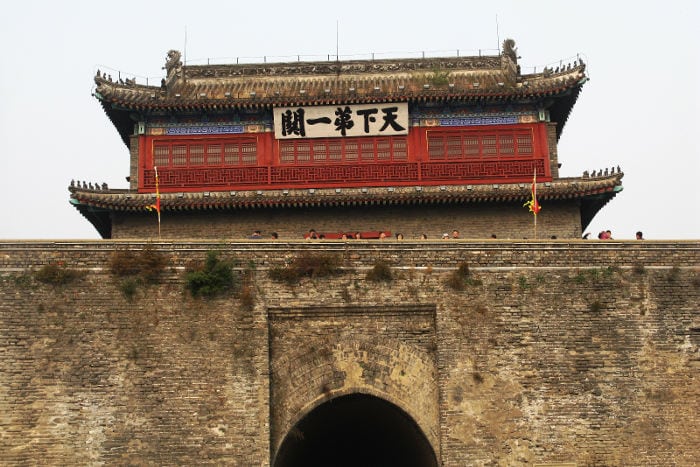
Qinhuangdao and Shanhaiguan
Qinhuangdao (秦皇岛) is a city with almost three million inhabitants situated on the Bohai Sea, in the southernmost area of the province. The city is known for its immense port, second in all of China when it comes to shipping coal, and its historic and tourist importance that makes it famous in the north of the country.
Getting and staying there
To get to Qinhuangdao, the best “bases” are without a doubt Beijing and Tianjin: these two metropolises are both just a few hours distant from the county which can be reached by bus or train (with the new high-speed trains it takes only two hours). If you’re somewhere else in China, you can even find flights going to the small city airport.
The hotels we would recommend for your trip are:
- 7 Days Inn: near the Olympic Sports Center (a relatively peaceful area). It’s a standard hotel with moderate prices;
- Shangri-La Hotel: once again near to the Olympic Sports Center with beautiful rooms and a sea view, the Shangri-La is a more luxurious and expensive hotel compared to the 7 Days Inn;
- Beijing Beidaihe Cadre Recuperate Hotel: a good hotel, located however in the suburb-tourist resort of Beidaihe, a few kilometers outside the actual city;
- Super 8 Hotel Qinhuang Ruhaichu: this hotel/motel is without a doubt best suited for younger travelers and those without any particular needs. It’s located practically in the city center and the prices are very good.
Click here to read our complete guide to booking a hotel in China.
As in every Chinese city, in the cheaper places, they can make a fuss because you’re not Chinese: Qinhuangdao is more flexible in this aspect, as its rather used to a large number of tourists that come to the city, especially in summer, and you’ll likely find somewhere to sleep without too much trouble.
In any case, if after reading this guide you don’t think it’s worth spending a night in Qinhuangdao, we can confirm that it is possible – with an early start – to just do it as a day trip from Beijing or Tianjin, without necessarily needing to spend a night there in a hotel.
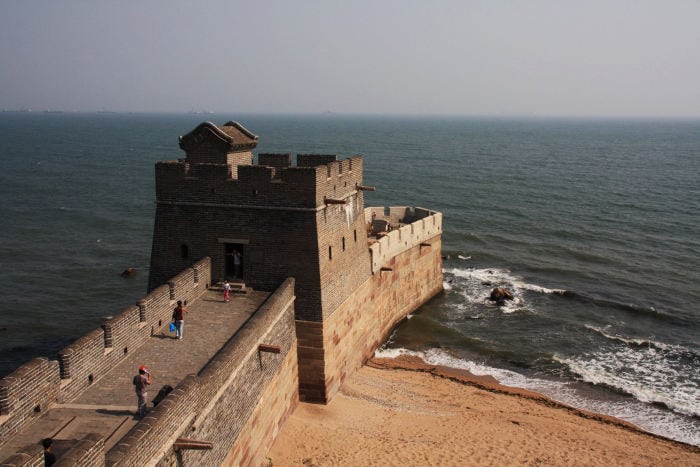
Main attractions
The Qinhuangdao region is especially famous for the numerous places where you can view sections of the Great Wall. The city center of Qinhuangdao, modern and anonymous, leaves a little to be desired as far as refinement and style goes (don’t worry about skipping it). The more interesting areas of the county are all just outside the actual city and are the following:
Shanhaiguan (山海关)
Shanhaiguan is an “administrative subdivision” of Qinhuangdao or a locality situated just outside the actual city. Here, in the first place, you’ll find the section of the Great Wall that gives the places its name (“shan” means “mountain”, “hai” means “sea”, and “guan” means “step”), and through which back in 1644 troops of the Manchurian army penetrated China, conquering it and becoming the last imperial dynasty of its history.
The most famous gate along the wall is known as Tianxia Diyi Guan (天下第一关, or “the first step under heaven”), which often refers to the entire site that near the old city hosts a sort of theme park.
At this point, the Great Wall also serves as an ideal line for identifying the border with nearby Liaoning Province.
The site is easily reached from the city by taking city buses 25 or 33, or directly from Beijing if you’re not staying in Qinhuangdao, by taking the train and getting off directly at Shanhaiguan Station.
After taking a tour of the old city – which is open to the public – you can enter the actual park by paying an insignificant fee.
At the ticket office in Shanhaiguan, you can also get a combined ticket that includes entrance to the site at Laolongtou. Don’t do it!!!
It will actually cost you 120 Yuan, or more than you’d pay by buying them separately.
Laolongtou (老龙头)
Laolongotu, literally “The Head of the Old Dragon”, is also considered to be the starting point of the Great Wall, a fortified bastion that goes right up to the sea.
Inside the park which eventually leads to the “head”, you can also cross over to the adjacent garrison, a sort of enormous fortified square barracks where you can relive the life of the soldiers and the various historical stages of the site.
Laolongtou is inside the suburban area of Shanhaiguan. We, therefore, recommend that you visit the two places on the same itinerary, going first to Tianxia Diyi Guan by bus from Qinhuangdao, and then moving on to Laolongtou with bus number 25 (if you want to skip Shanhaiguan, it’s also possible to take bus 25 from Qinhuangdao and get off at Laolongtou).
The entrance fee costs from 20 to 50 Yuan depending on the season.
Despite the indubitable appeal of the place, the number of tourists is not excessive to the point of being bothersome, and the site deserves a visit if only for the spectacular views and to admire the sea from the Head of the Old Dragon, knowing that you are at the extreme point of an ancient work that snakes inland for thousands and thousands of miles.
Beidaihe (北戴河)
While the ancient soil of Shanhaiguan in the northern periphery of Qinhuangdao, in the southern outskirts of the city you’ll find the summer resort of Beidaihe, a maritime area known throughout the country and characterized by a strong tourist presence, which in the summer teems with Russian tourists and Beijingers looking to escape the chaos and heat of the capital.
The Beidaihe promontory is famous for being one of Mao Zedong’s favorite places, as well as a source of inspiration for one of his poems written while he observed the sun suspended over the sea’s horizon (the park doesn’t lack a statue of the “Great Helmsman” on the promontory memorializing that event with the poem inscribed on the base).
The area is known worldwide as a bird-watching paradise, and locals have the custom of going to the resort’s beaches to watch the sunrise.
To get there, take city bus number 34 from Qinhuangdao train station and get off at Beidaihe.
Shijiazhuang
It doesn’t matter how many tourist guides you’ve read up to this point, or how many films or documentaries you’ve seen on China: Shijiazhuang (石家庄) is probably not a name you’ve come across.
The city was little more than a village up until the beginning of the last century; today it has more than four million inhabitants just in the urban area along, and plays a role as Hebei’s regional capital. It is dominated by extremely modern architecture and is well-established among the top ten most polluted cities in the country.
Situated in the western part of the province, its importance comes from its strategic position, from which it is possible to explore any of the places of interest in the surrounding provinces.
Getting to and staying there
From Beijing or Tianjin, the city is easily reachable by train (the trip lasts from 2 to 5 hours depending on the type of train you choose); it is also convenient to get there by air via the modern airport if you find yourself in another part of China.
Regarding hotels, it is necessary to know that foreigners are generally nor admitted in the cheapest places. These are the hotels that we’d recommend:
- 7 Days Inn: Like its counterpart in Qinhuangdao, this hotel offers decent service at a good price and is located in a rather central location in the metropolis;
- Home Inn: at two steps away from the train station its prices are rather good;
- Huiwen Hotel: Exactly across from the station, it is a bit more luxurious than the Home Inn and has a better quality restaurant and various services.
Click here to read our complete guide to booking a hotel in China.
If you are a student, it’s worth checking with the various universities in Shijiazhuang, where you also might be able to find lodging at a moderate price.
Even then, depending on the itinerary you choose, a day trip from Beijing can be a possibility, even though it requires greater cost and organization than in the case of Qinhuangdao.
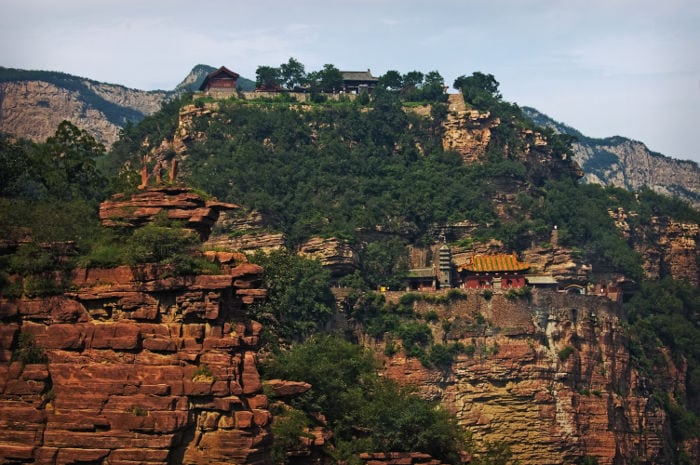
What to see in Shijiazhuang
As you could probably figure out from the initial introduction, the city in and of itself is not a source of many surprises (anything but), but can be considered an excellent base camp for exploring the surrounding area. Besides the places of interest we’ll consider below, you can also leave from here for the bordering provinces of Shanxi, Henan, and Shandong.
Zhaozhou Bridge(赵州桥)
Zhazhou Bridge, built around 600 A. D., is today considered the oldest stone arch bridge in the world. At about 50 meters long, it is also the oldest stone bridge in China.
To reach the site, take bus 35 from the train station to Nanjiao station; from here, take the bus that brings you to Ninjing (宁晋县) county; get off at the reference station and take a nice walk of about a kilometer to reach the bridge. The entrance fee which also includes a visit to the museum next door costs 30 Yuan.
Cangyan Shan (苍岩山)
Cangyan Mountain will satisfy more adventurous spirits and lovers of open-air touring (as well as avid photographers of the breathtaking landscapes). During the climb you can admire, aside from the spectacular typical Chinese mountain scenes, a notable number of temples and other religious buildings built in precarious conditions, balanced on the edge of cliffs.
You should definitely not miss this place on your itinerary if you visit this part of China. Note that some of the scenes from the film “The Tiger and the Dragon” were filmed along the trail you take when visiting the mountain.
The entrance fee is 30 Yuan.
In order to enjoy the experience calmly, it is recommended that you cover the entire pathway on foot (it takes about two and a half hours), and to do so you’ll need to get up early in the morning and catch the earliest bus possible. The site is about 80 kilometers southwest of the city and can be reached in two ways:
From the central bus station, take number 9 to Xiwang station (西王客运站, Xīwáng Kèyùnzhàn), and from there take the direct bus for Cangyangshan (there’s only one at 8.40);
Otherwise, there are more regular buses that will bring to Jingxing (井陉) in an hour, where you’ll have to take another to Cangyangshan (another hour). In both cases, the return trips to Shijiazhuang always leave not much later than the early afternoon, so give yourself lots of time and get up at the crack of dawn!
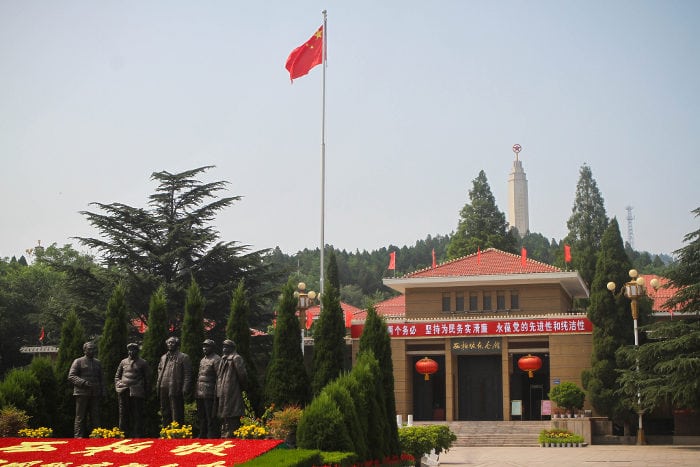
The village of Xibaipo (西柏坡)
The village of Xibaipo, lastly, is a must for fans of the Chinese Communist Party. It is here, in fact, that the headquarters of the Central Committee and general quarters of the Liberation Army resided in 1948-49 when Mao’s Red Army prepared to march on Beijing.
These days the village is home to numerous tourist sites, all concerning patriotic memories. The building hosting the ex-PCC base is still authentic, while other sites such as the Garden of Monuments and Memorial Hall were built in later periods (this last one, in particular, is sort of a museum that exhibits various relics of the “patriotic cult”, with President Mao’s desk being first and foremost)
The most comfortable way to get to Xibaipo is without a doubt taking one of the direct buses that leave from the hub near the train station north of Shijiazhuang (石家庄北站, Shíjiāzhuāng Bĕizhàn), that gets to the village in about two hours. Entrance to tourist sites is free.
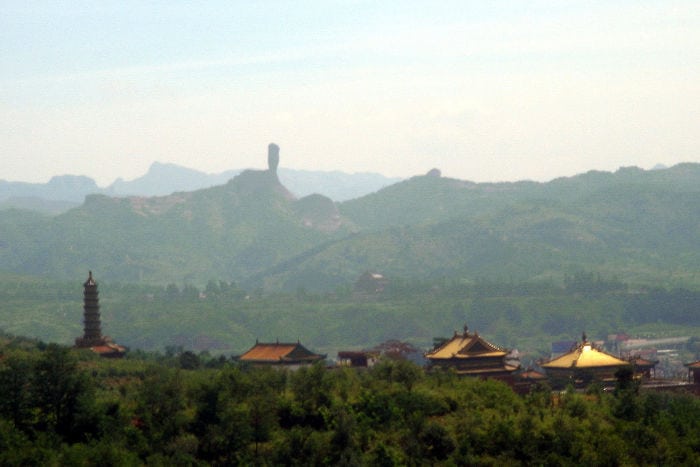
Chengde
Situated in the northeast of the province, about 260 kilometers from Beijing, this small city is famous for being the summer residence of the Qing Dynasty emperors. The complex of buildings still exists and was declared a World Heritage Site in 1994.
With less than a million inhabitants, Chengde offers a more rural and relaxed atmosphere compared to the large Chinese megalopolises and can be considered an excellent ploy for enjoying a little fresh mountain air in peace.
Getting to and staying there
Chengde is easily reachable from Beijing by train or bus. With the high-speed train line still under construction, the trip will take at least half a day. The city is just as reachable from Qinhuangdao, but not by train (unless you go through Beijing): the available options are a long-distance bus from the bus station or, for the more enterprising, a “private” taxi (one without a license), that should cover the distance in about two and a half hours, and for a price that’s anything but excessive.
Regarding lodging, we recommend the following options:
- Ming’s Dynasty Hostel: without a doubt the tops for all sorts of travelers. Prices are reasonable and the staff is used to western customers;
- Shenghua Hotel: a hotel that’s better suited for those traveling with the family. Prices are slightly higher than Ming’s, but still not comparable to those in bigger cities, and its location in the city is just as good.
What to see in Chengde
The imperial complex is certainly the main attraction, but at the same time by adventuring down less-beaten paths you can find surprises that are just as pleasant.
Imperial summer residence of the mountain town of Chengde (避暑山庄)
A UNESCO World Heritage Site, this complex of palaces and temples took around ninety years to be completed (1703-1792). Varying types of ceremonial and residential buildings are spread throughout the park (which is enormous), and are founded in a harmonious way with the surrounding nature; some were built according to the architectural styles of a few ethnic minorities and are therefore particularly intriguing.
The buildings, just like the Buddhist statues and frescoes were conserved so as to preserve the originals as much as possible in testimony to the unique Chinese culture of the eighteenth century (among other things, an imposing stone pagoda of about 70 meters).
The entire complex is divided into four main areas: the lake area, the grassland area, the mountain area, and the palace area. This last one, where you can find the temple-palace of Putuozongcheng which we will describe in greater detail below, is the most famous and flamboyant.
Putuozongcheng Temple (普陀宗乘之庙)
This is the most unique and representative building in the complex; this enormous structure was inspired –to use a euphemism – by the Potala Palace of Lhasa, in Tibet. To be honest, it can be well described as a Chinese version of the same building (that why its called Xiăo Bùdálā, 小布达拉, by locals, meaning “Little Potala”).
In any case, the palace is without a doubt an exceptional architectural work, with its corridors/balconies and two audience halls where the emperors received their guests during their summer stays in Chengde.
Located about a half kilometer from Little Potala, another building that merits a visit is the Puning Temple (普宁寺, Pŭníng Sì), known also as “Temple of the Great Buddha” (大佛寺 Dàfó Sì). Inside a giant wooden statue of a Bodhisattva has been preserved, and the complex, in general, is very interesting and well-preserved.
There is an infinite number of city buses that allow you to get to the site (just get off at the stop with its name. or 避暑山庄, Bìshǔ Shānzhuāng). Otherwise, a taxi ride is just as convenient and will cost from 20 to 30 Yuan depending on where you leave from. The entrance fee varies between summer and winter.
When we visited (summer) it cost about 150 Yuan; in winter the price is probably less but at the expense of harsher weather that surely isn’t best for a tour of this nature.
To conclude, the park is enormous, and to see it all on foot would require an entire day. Inside there’s a shuttle service with a daily ticket rate of 50 Yuan.
Shuangta Shan (双塔山)
Shuangta Shan, or the “Twin Peaks”, are two rocky pinnacles that rise up next to each other in the crest of a hill. Their appeal is not for being some forty meters tall, but rather for hosting a pair of ancient pagodas that are of unknown origin and around a thousand years old on their summit!
For fans of ancient China and romantic strolls that seem right out of a Zhang Yimou film, this is an excursion that you don’t want to miss!
The site is in the area of Shuangluan (双滦), a village not far from Chengde. You can reach this village by one of the bus lines (such as numbers 5, 15, and K1), but the trip will take more than two hours. Our advice is to take a taxi, especially if traveling in a group so that you can get there in about a half-hour (the price will still be reasonable).
The entrance to the area (which includes the twin peaks and a walk in the surrounding mountain park) is 50 Yuan.
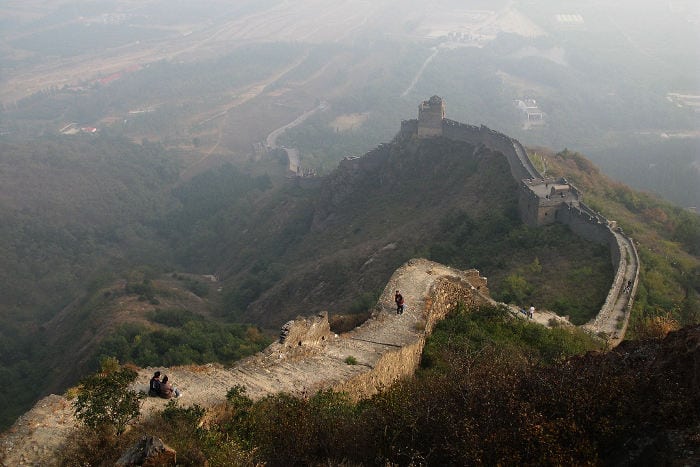
The Great Wall of China (and why Hebei is the best place to visit it)
The Great Wall of China is the symbol par excellence of the culture and tourist value of this ancient land. Even though the more famous and visited sections are those surrounding Beijing, we’ll lay out three reasons why in our opinion Hebei Province offers the best conditions for exploring this wonder of the world.
- Proximity to the sites of Beijing: well yeah, if you haven’t yet visited it, the crowded sections situated in the capital municipality are nearby for those traveling to Hebei: considering the geographical position of the province, it is extremely convenient and doable to stop and admire one of these sites while moving from one spot to another in Hebei.
- Tranquility: anyone who has visited (or tried to visit) varying sections of the wall located near the capital knows for sure that it is impossible to fully enjoy the spectacle due to the hordes of tourists. Imagine now finding yourself alone (alone!!!) walking along a remote section that has not been rebuilt. It is extremely quiet on the wall while the wind whistles in your ears, the thousand-year-old bricks crumbling from time, and the elements crackle under your every step. If you’re trembling in expectation of just the thought, know that Hebei is the province for you!
- Abundance: the region hosts about 15% of the entire work, and there are more than twenty sections that have been preserved over time and are able to be visited, the majority going back to the Ming period.
Let’s go into detail about our favorites:
“The Head of the Old Dragon” and the Shanhaiguan area
Located in a suburb of Qinhuangdao, we talked about it in detail in the preceding section of the article. Marked by strong historic importance and the epic sea views that it offers, these two sites deserve a visit regardless of your tour preferences.
Jiao Shan and Jiumenkou
These two sections of the wall, characterized by the almost total absence of tourists during the majority of the year is also located near Qinhuangdao, and each can guarantee a pleasant experience: Jiao Shan (角山) is the first true mountain that the wall climbs, and at the end of its steep and tiring ascent you’re compensated with a breathtaking panorama spread out on the surrounding plains.
More special is the Jiumenkou section (九门口, literally “the nine gates”); in an arid and barren region of low mountains, a river (truthfully almost dry) crosses a dusty valley: on this the wall passes through undisturbed, crossing only thanks to a solid bridge with nine arches – from which it gets its name – to then once again scramble up the mountain. The highest part on the hill is (in theory) off-limits (nobody is there to check!), has never been rebuilt, and is little more than a path of crumbling bricks raised above the ground without parapets or pavement.
Under the Wall lie military tunnels from the Ming period, a shaft about a kilometer long that soldiers used in different ways during battles also merits a visit (strongly not recommended for claustrophobics).
To get to Jiao Shan, you must first go to Shanhaiguan (only 3 kilometers away), and then take bus number 25 or 33, or a cheap taxi. The entrance fee at the time of our visit was 30 Yuan; the prices can fall in the winter but a visit at that time of year is not recommended considering the topography of the site.
To get to Jiumenkou, instead, you’ll need to take a taxi, unless you’re part of an organized tour. The trip there and back will cost about 100 Yuan. Entrance to the park including the Ming Tunnels costs 90 Yuan.
The two places can be visited in a day, or in a joint tour with the sites in Shanhaiguan. One piece of advice: get up early and keep a good pace!
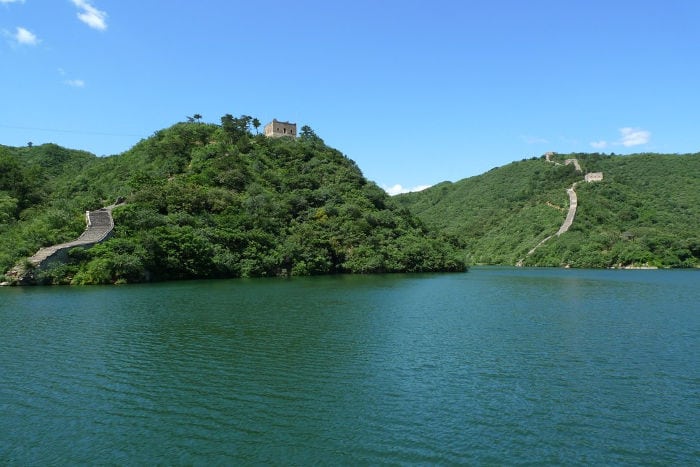
Xifengkou – The Drowned Wall
Situated about two hours north of Beijing, this section of the wall is the only part that has an underwater portion (yes, you heard correctly!). The dragon snakes down the hill and throws itself headlong into the lake where it follows its course to then reemerge and once again scramble up the mountains.
This particularity is due to the construction of the dam in the Panjiakou Reserve: the waters of the artificial lake created afterward grew year after year, eventually swallowing up the flattest section of the wall.
In the wildest part of the Reserve, this site is only reachable by boat; for the more enterprising, you can also rent scuba equipment and dive at the site (at your own risk and danger!).
It’s also possible to run into many Chinese tourists in the park who – especially during the weekend – enjoy various common activities: from canoe races to fishing to climbing the dam.
In any case, both the submerged and “land” sections of the wall are preserved in excellent condition – they’ve never been reconstructed over time, as opposed to other famous sites – and this detail together with the singular uniqueness of this section surely makes it one of the not to be missed locations if you’re passionate about the Great Wall.
P.S.: This is also the place in 1933 where one of the most celebrated (and glorious) battles of the Chinese resistance to the Japanese invasion took place.
To reach the Panjiakou Reserve, you’ll need to transit through Tangshan. You can get to this city through one of the many trains from Beijing or Qinhuangdao (in both cases it will take a couple of hours maximum), and then from Tangshan take any bus from any station that goes to Qianxi County (our suggestion is to leave from the east bus station where many leave for Qianxi at a cost of about 25 Yuan).
Once you get to Qianxi, the best option for getting to the Panjiakou Reserve is certainly to take a taxi (it will cost you a couple of hundred Yuan).
Entrance to the park costs 30 Yuan, you’ll have to pay extra if – as assumed – you’ll take a boat tour of the wall at Xifengkou.
This type of excursion will certainly take a full day – unless you stay in Tangshan or its surroundings – but man is it worth it!
Conclusion
In this guide we sought to present what in our experience are the best points of interest in Hebei; the region however hides a number of enormous landscape and cultural treasures in the more rural areas of the province.
Never limit yourself to the mere “tourist” experience of a place! Explore, follow your instincts and curiosity: China, with its boundless territory and great inequality between its urban and rural areas that characterize it can surely hold more than one surprise from this point of view.
Photo Credits: ![]() 东海滩 by Smartneddy
东海滩 by Smartneddy
![]() First Pass Under Heaven / 天下第一关 by Caitriana Nicholson
First Pass Under Heaven / 天下第一关 by Caitriana Nicholson
![]() Shan Hai Guan 060 by 若昔难得
Shan Hai Guan 060 by 若昔难得
![]() Cangyan Mountain by Jeff
Cangyan Mountain by Jeff
![]() IMG_4735 Xi Bai Po 西柏坡 by Mark爱生活
IMG_4735 Xi Bai Po 西柏坡 by Mark爱生活
![]() 03065a by wang leon
03065a by wang leon
![]() Jiao Shan Great Wall / 角山长城 by Caitriana Nicholson
Jiao Shan Great Wall / 角山长城 by Caitriana Nicholson
![]() Untitled by Jeff Mao
Untitled by Jeff Mao



